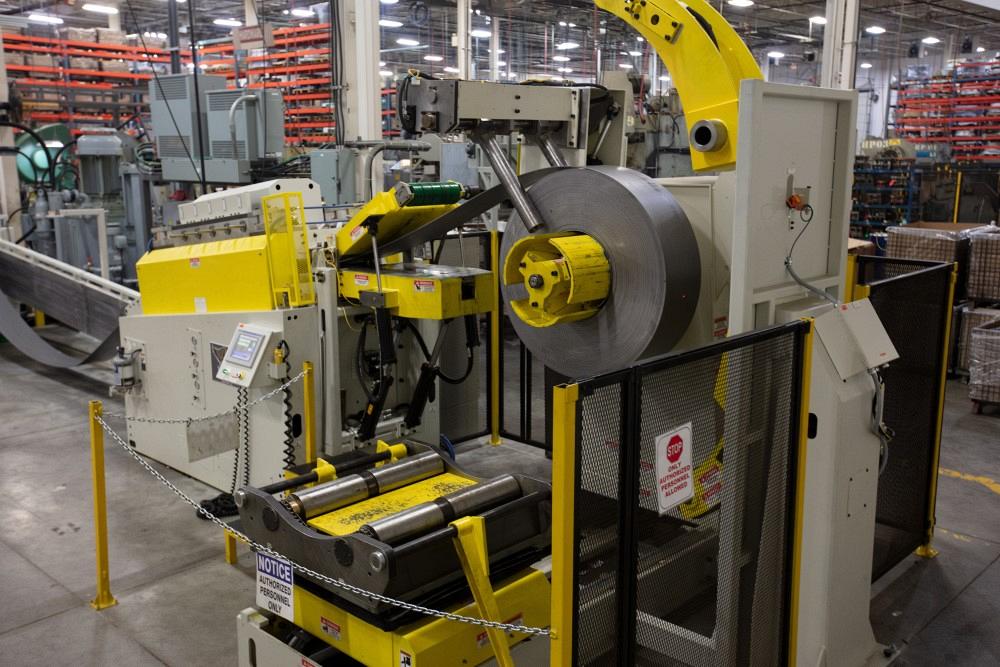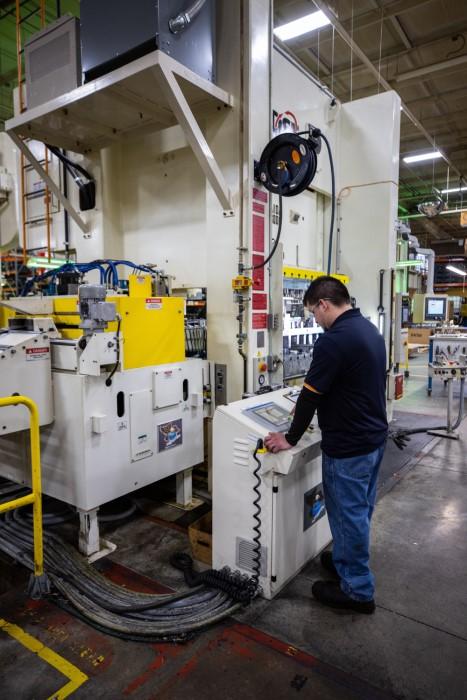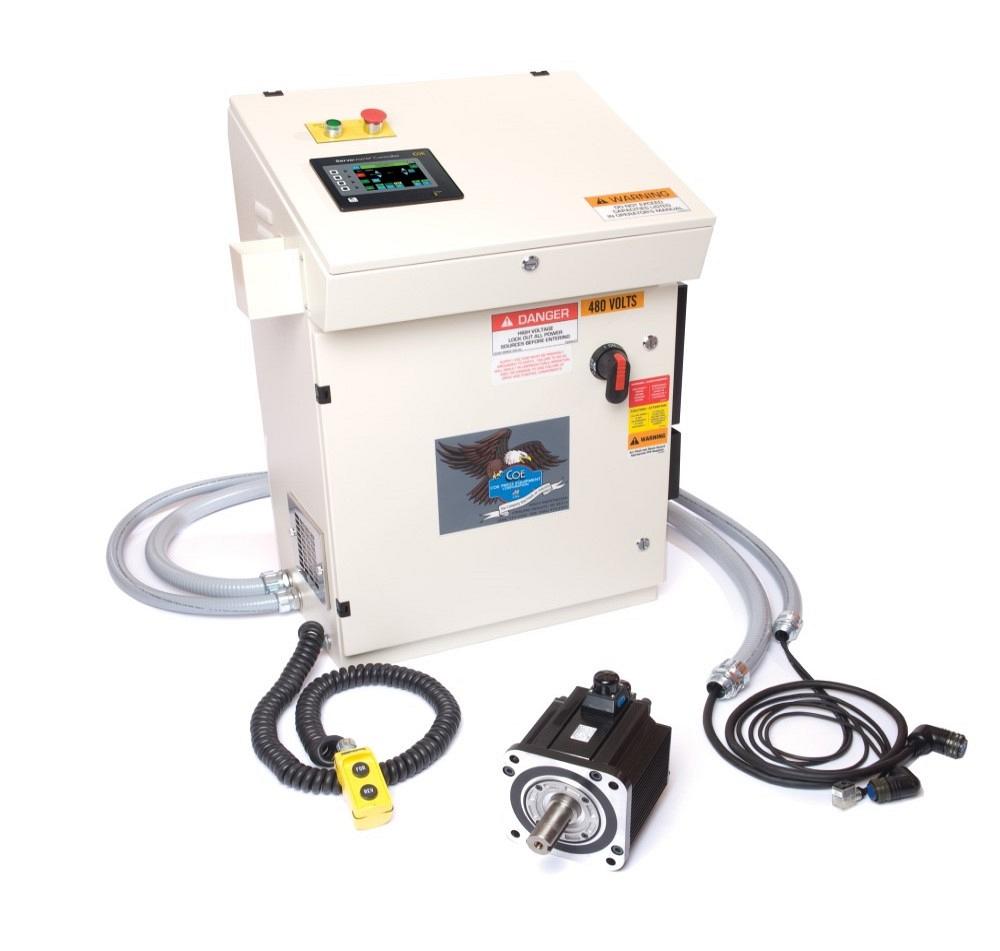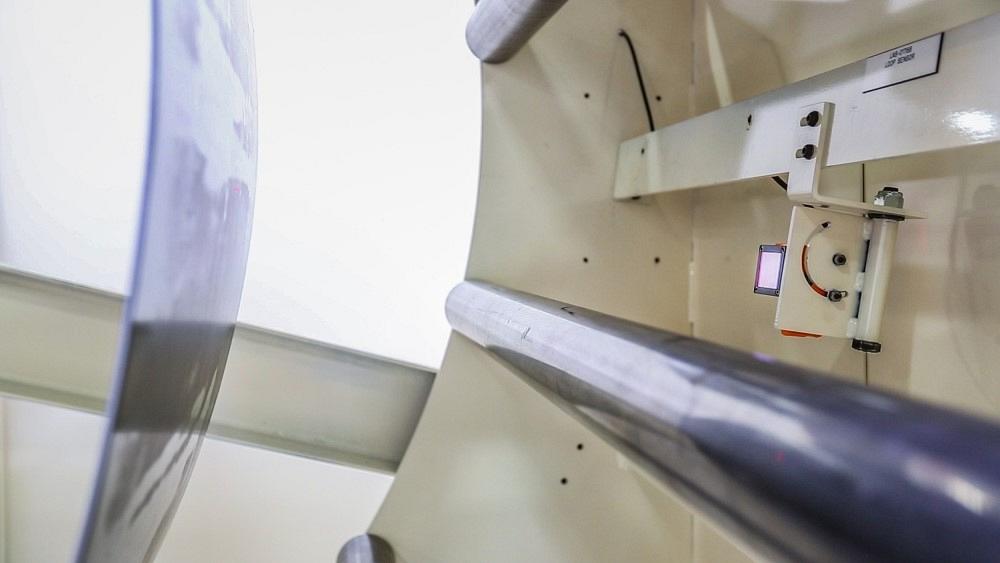Regional Sales Manager
- FMA
- The Fabricator
- FABTECH
- Canadian Metalworking
Categories
- Additive Manufacturing
- Aluminum Welding
- Arc Welding
- Assembly and Joining
- Automation and Robotics
- Bending and Forming
- Consumables
- Cutting and Weld Prep
- Electric Vehicles
- En Español
- Finishing
- Hydroforming
- Laser Cutting
- Laser Welding
- Machining
- Manufacturing Software
- Materials Handling
- Metals/Materials
- Oxyfuel Cutting
- Plasma Cutting
- Power Tools
- Punching and Other Holemaking
- Roll Forming
- Safety
- Sawing
- Shearing
- Shop Management
- Testing and Measuring
- Tube and Pipe Fabrication
- Tube and Pipe Production
- Waterjet Cutting
Industry Directory
Webcasts
Podcasts
FAB 40
Advertise
Subscribe
Account Login
Search
Approaches for improving press feed operations
3 options without breaking the bank: Do some yourself, outsource some, automate some
- By John Kwiatkowski and Tom Brokie
- January 27, 2022
- Article
- Materials Handling

One way to reduce coil changeover time without new equipment investment is by prestaging with coil cars.
Every company is well aware that finding skilled workers can be a challenge. A recent National Association of Manufacturers study reports that nearly one-quarter of the workforce is age 55 or older, with many preparing to retire. At the same time, the coronavirus and all that comes with it has contributed to an exodus of people from the workforce. The most common complaints heard in the pressroom are the lack of trained workers, supply chain holdups, and a struggle to gain efficiencies.
The good news is that there are many ways to improve the performance of your press feed without breaking the bank.
What You Can Do Yourself
The first place to make improvements is with your own people and processes. Many workers are aging baby boomers with years of equipment experience. However, this experience often is stored only as tribal knowledge, trapped in their heads but not formally documented anywhere. Once these workers retire, they often leave a vacuum of technical capability. This means that new personnel will start to do things without experience or documented methods, which more than likely will result in a lot of wasted time and quality problems.
There is a straightforward fix for this situation. First, take the time to find out who has the tribal knowledge, document it, and turn it into common knowledge that can be shared. Then new employees can start off with a baseline of knowledge that will make them much more effective.
Second, identify your best practices. If you observe a big variance in output or quality between shifts, identify what is different between them. Then, based on that information, figure out the best way to go forward. Again, this requires documentation so that everyone is moving forward with the same goal and understanding.
For example, let’s say the day shift is consistently capable of running five coils per shift, while the night shift can run only four coils. It would be important to capture the approaches applied during the day shift so the night shift can benefit.
Let Service Experts Boost Your Productivity
No company intends to function at less-than-optimal productivity, but the daily grind can get in the way of relatively simple improvements. Or perhaps you are so pressed for resources that you don’t even have time to collect and document your tribal knowledge.
Fortunately, external service experts, such as those from press feed OEMs, can come into your plant to analyze your current operations and then make recommendations that can go a long way in improving your press feed performance. They can help identify small ways to lower costs and increase output, which can be the difference between meager growth and desired profit.

An audit of your equipment performance by an outside source can help reveal hurdles that are keeping you from reaching your productivity goals.
Start With an Audit. The best way to start is through an audit of your current operations. An audit can help uncover what hurdles are keeping you from reaching your productivity goals. This analysis will then help you focus on areas where the most important changes are needed. For example, it could reveal a machine with below average reliability, a rising trend of falling quality, and a skill deficit indicating a need for training.
Make Adjustments. Once bottlenecks are identified, adjustments can be made to the equipment or process to dramatically improve line speed and increase output. After a service visit, you may be able to eliminate overtime running the same throughput. Or you may be able to run the feed line two times faster after one day of production support.
Upgrade Drive. In certain situations, service experts might identify older equipment that may be constraining straightener or reel line speed. Many progressive press lines originally were specified to run at a maximum speed of 40 to 60 SPM. To reach higher coil rate speeds of 80 to 100 SPM, it may make sense to upgrade the machine drive and reducer package. Yes, this involves an investment, but with a 100% improvement in productivity, the ROI would be obtained quickly.
Reduce Coil Changeover Time. Another way service experts may recommend that you boost your output without purchasing a new equipment line is by reducing your coil changeover time. If you typically spend 15 minutes to change a coil and run eight to 10 coils per day, you are spending two days a week, or more than 100 days a year, of potential production time. Minor changes in your process can reduce changeover time almost immediately. For example, prestaging with coil cars can provide uptime immediately. A double-ended reel also will allow for quicker coil changes if there is room for this addition. If you don’t have these features on your line, you can add them.
Replace Threading Drive. Additionally, given the increasing use of advanced high-strength steels, in some instances your existing equipment can benefit from upgrades to the threading drive system. Your equipment can be upgraded with the addition of hold-down arms, lower holdup arms, and motorized end wheels to both speed the threading process and ensure worker safety.
Automation Makes the Machine Do the Work
Some stampers have compensated for the lack of skilled workers to run the equipment and subsequent rising wages with automation. Automation is an increasingly attractive way to address the labor shortage while quickly adding efficiency and productivity to your coil processing operations.
Programmable Speed. Many original straighteners and reels in coil feeding systems were designed with simple drive mechanisms, while today’s variable-speed controls are programmable. Programmable speed controls allow you to develop custom parameters to optimize machine performance used in uncoiling and straightening functions. You can use them to provide the proper torque necessary for these operations. Machine settings and adjustments such as passline height, edge guide, and straightener roll depth can be upgraded effectively to motorize mechanisms, helping to increase speed and consistency significantly.
Controls Upgrade. An easy way to add automated functions to the line is through a controls upgrade. Many roll feeds are still in operation today with outdated operator interfaces that offer only basic setup functions for feed progression and speed percentage, limiting feed effectiveness in today’s stamping operations. With an upgrade to a modern device, you can gain access to many time-saving features such as storage recipes, operator prompts, servo feed diagnostics, multilingual programming, and direct downloading of parameters from the host press.
Many controls package upgrades can be accomplished over a weekend so you don’t lose production time. Plus, these controls offer automated setup with feed and work roll adviser software wizards. These tools calculate the feed speed and acceleration and straightener work roll settings for the operator, all helping to reduce setup time, improve consistency, and raise productivity.

Investing in a controls upgrade is a quick and easy way to add automated functions to an older line.
Loop Control. Another way to add simple automation to the line is through loop control upgrades. While original loop control systems are often simple on/off switches, modern loop controls are based on ultrasonic, photo-eye, and laser beam noncontact technologies for higher quality requirements. Loop height and response output signals are then programmable to achieve optimum coil line performance for each job setup.
By taking the guesswork out of the operator’s hands with the newer controls features, you will see immediate improvements in part quality and productivity. You might also be able to reduce the hours of operator training needed. With updated features built into new controls, you may be able to train a new operator faster and get them to hit the ground running.
About the Authors
Tom Brokie
Regional Sales Manager
40549 Brentwood Drive
Sterling Heighs,, MI 48310
586-979-4400
Related Companies
subscribe now

The Fabricator is North America's leading magazine for the metal forming and fabricating industry. The magazine delivers the news, technical articles, and case histories that enable fabricators to do their jobs more efficiently. The Fabricator has served the industry since 1970.
start your free subscription- Stay connected from anywhere

Easily access valuable industry resources now with full access to the digital edition of The Fabricator.

Easily access valuable industry resources now with full access to the digital edition of The Welder.

Easily access valuable industry resources now with full access to the digital edition of The Tube and Pipe Journal.
- Podcasting
- Podcast:
- The Fabricator Podcast
- Published:
- 04/16/2024
- Running Time:
- 63:29
In this episode of The Fabricator Podcast, Caleb Chamberlain, co-founder and CEO of OSH Cut, discusses his company’s...
- Trending Articles
AI, machine learning, and the future of metal fabrication

Employee ownership: The best way to ensure engagement

Steel industry reacts to Nucor’s new weekly published HRC price

How to set a press brake backgauge manually

Capturing, recording equipment inspection data for FMEA

- Industry Events
16th Annual Safety Conference
- April 30 - May 1, 2024
- Elgin,
Pipe and Tube Conference
- May 21 - 22, 2024
- Omaha, NE
World-Class Roll Forming Workshop
- June 5 - 6, 2024
- Louisville, KY
Advanced Laser Application Workshop
- June 25 - 27, 2024
- Novi, MI



























